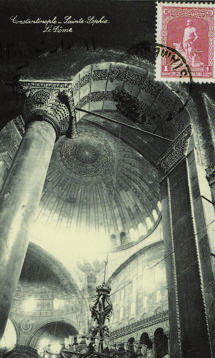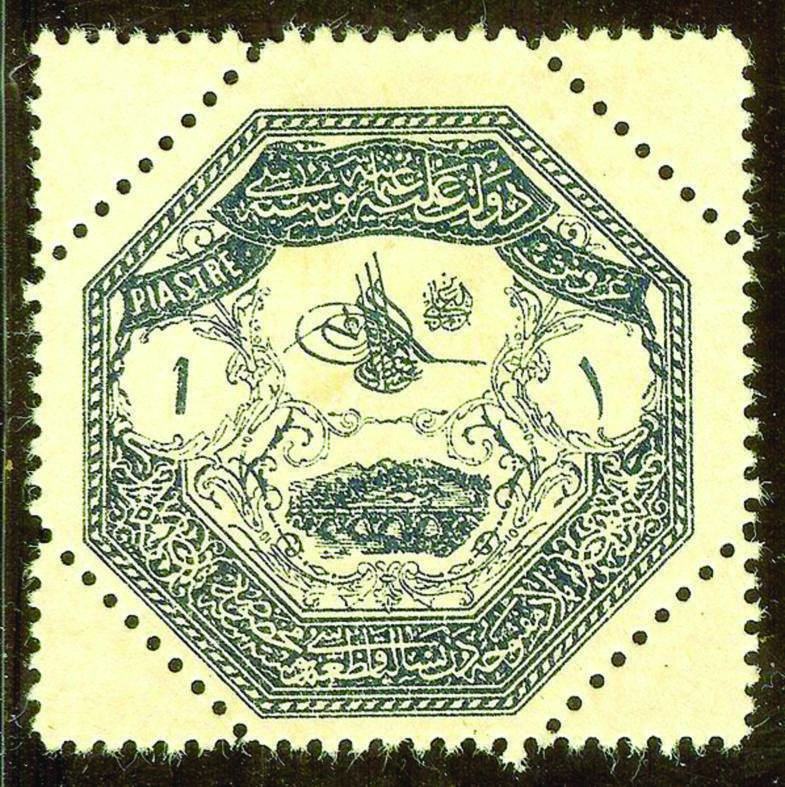Postal service among the Ottomans
Niki GAMM ISTANBUL – Hürriyet Daily News

The Selimiye Mosque in Edirne, 1913.
Last month the Turkish PTT (Posta Telefon Telegraf) opened the doors of its postage stamp museum in Ankara and showed off some of the many “treasures” that it had been storing in its depots for 173 years. The permanent exhibition has stamps from the earliest period, stamp designs, equipment and
even short films.
The earliest postal service in Turkey, that is, in the Ottoman Empire dates from the sixteenth century when Grand Vizier Çelebi Lutfi Pasa (g.v. 1539-1541) organized a relay service on behalf of the government. It was used to transmit the orders of the sultan and return information about what was happening elsewhere in the Empire. This system was not available to the general public who had to rely on caravans, travelers, pilgrims and not too reliable private messenger services. The foreign embassies of Russia, France, Italy, Britain and Austria also had their own postal services under the so-called capitulations which granted foreigners special privileges. Germany, Poland and Romania also maintained post offices.
This was the situation until the 19th century. Sultan Mahmud II issued a decree in 1832 that was aimed at reforming the postal service. This was in concert with his other attempts at reform in his effort to modernize and westernize the Empire, as Ayşegül Okan has written. He was also intent on opening the postal service to all citizens regardless of their status in order to increase the empire’s revenue. Others attempted to set up various postal schemes which didn’t work very well until 1840 when a committee was established to provide a system that worked the way postal systems in Europe operated. The Ministry of the Post was established on 23 October 1840. Its duty was to provide postal services for private individuals as well as the government and the first road link went from Istanbul to Edirne.
 Postal stamps and cancellations
Postal stamps and cancellationsThe first known hand stamps issued in the Ottoman Empire date from 1840, and the first postage stamps in 1862 (or possibly 1863, there seems to be some confusion about the date). The first postage stamp was introduced in 1840 by the British. These first stamps showed the tughra (the sultan’s signature) of the current sultan, Abdulaziz, over a crescent in which Devleti Aliye Osmaniye, or “The Sublime Ottoman Empire” was written. The rest of the stamp was filled with a baroque decoration. The first stamps were printed in Istanbul but were seen as low in quality in comparison with the stamps of western countries. So postal officials decided to have their stamps printed in Paris as the Greeks had begun to do so two years earlier. This resulted in the series known as the Duloz stamps, which had an oval center containing a crescent moon and sun. These were printed between 1865 and 1876. When however an Armenian suggested that he could print them in Istanbul more cheaply, the Ottoman government accepted his proposal and the plates were sent to Istanbul, where printing began in 1868.
In 1875, the General, later Universal, Postal Union was founded in order to coordinate the many mail services that had sprung around the world, and the Ottoman Empire was a founding member. The goal was to unify rates and weights and terms of acceptance. The following year the Ottomans issued a new set of stamps known as the Empire series. These were printed until 1890 and bore a crescent with the same writing as that on the Duloz stamps. The difference was now that the Ottomans belonged to the Postal Union, they started to add value to their stamp by having them printed in western languages, French or English. From then on until the end of the Ottoman Empire a variety of stamps were issued ranging from depictions of soldiers during World War One to important buildings.
Appearance of postcardsIn the foreword of the book written by Robert Ousterhout and Nezih Başgelen wrote, titled “Tarihi kartlarda yasayan Istanbul,” the book’s authors provide an overview of the history of the postcard. We learn that America’s private sector produced the first postcards in 1861 and the government only began printing cards with stamps in 1872. It proved so successful that some 60 million were sold in the first six months. The first postcards appeared in Europe, issued by the Austrian government in 1869. They were of a standard size and shape with a stamp printed on them. Although they were initially thought to be useful for trade, they proved to be so successful that half a million of them were purchased in the first month they were issued. Other European governments then hurried to print their own postcards.
The first postcards with pictures appeared in 1870 during the Franco-Prussian War, providing an easy means for the soldiers on both sides to communicate with their friends and loved ones. While most European countries produced such postcards, it was Germany, Austria and Switzerland which produced the most by far, succeeding in selling them in other countries. Most of the postcards sold in America in the 1890s came from Germany.
 Postcards that bore the names of Allah forbidden
Postcards that bore the names of Allah forbidden Similarly the oldest postcards used within the borders of the Ottoman Empire were printed in Austria and Germany and brought from there. There were limits in some European countries on what kinds of postcards could be sold and sent, such as nude figures. However the Ottoman government in 1890 forbade postcards that bore the names of Allah or the Prophet Mohammed, pictures of religious buildings, such as the Kaaba in Mecca, and portraits of Muslim women. A few years later Sultan Abdulhamid II outlawed cards that depicted Yıldız Palace and its gardens.
What contributed greatly to the spread of the picture postcards were advances made in photography from the first half of the nineteenth century onwards. In spite of these developments, it wasn’t until the 1890s that the first photograph postcards were developed. In 1906 the concept of having the address, writing and postage stamp on the same side while a picture appeared on the reverse was officially accepted.
As one might expect, Istanbul remained somewhat behind Europe. The first photography studios in the city were set up by foreigners and this remained the case through most of the nineteenth century. The first one was set up in 1845 by two Italian brothers. It wasn’t until the 1890s that postcards began to be used in Istanbul. Max Fruchtermann began selling the first postcards in 1895 from his store in Pera. In the beginning he had the postcards printed in Germany and Austria but later began producing them in Istanbul. He put out as many as 3000 postcards on various subjects while a rival of his only turned out 1200 different cards. These two men and others turned out many postcards that today give us an idea of what Istanbul looked like at the end of the Ottoman Empire.

 Postal stamps and cancellations
Postal stamps and cancellations